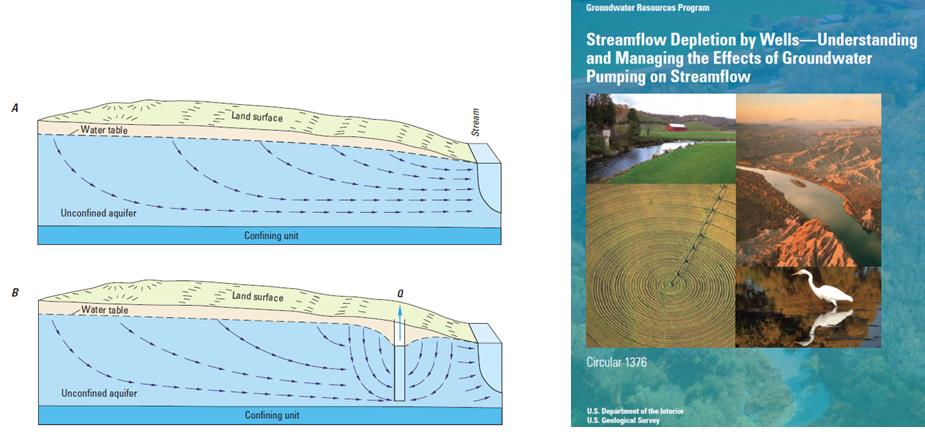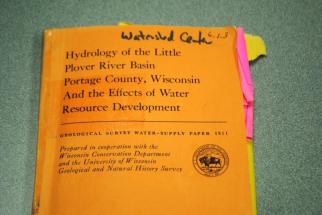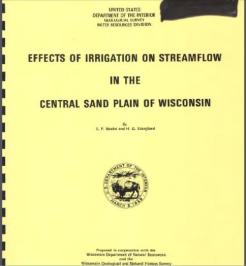I can get pretty grumpy about certain things.
In my professional life I get grumpy about claims that there is no science that groundwater pumping is drying central sands lakes, streams, and wetlands. It’s been 10 years since the Little Plover first dried, nine years after Long Lake did the same, and a dozen years or more since the public was last able to swim at the Wolf Lake county beach. And still one hears and reads the claim of “there’s just no scientific evidence connecting groundwater pumping and drying surface waters” or “we just don’t know enough about the geology and how water moves underground.”
These claims ignore that the science of groundwater flow in general has been well known for 150 (some would argue 400) years, and that we’ve had 50 years of studies in the central sands. And that the geology of the central sands is incredibly well known because few places in the world have so many holes poked in the ground, thanks to the large number of high capacity wells.
Soooo….
 I’ve started carrying a box with me that contains some of the volumes of central sands groundwater work. When the “no science” or “we just don’t know” claims come up, the box gets unpacked. People are amazed – even those who are savvy about the groundwater pumping situation.
I’ve started carrying a box with me that contains some of the volumes of central sands groundwater work. When the “no science” or “we just don’t know” claims come up, the box gets unpacked. People are amazed – even those who are savvy about the groundwater pumping situation.
Why the “no science” or “we just don’t know” claims? Certainly some folks are just unaware. (That’s why I’m writing this piece).
 But don’t disregard how well a willful ignorance works to cloud issues and delay change. “It’s easier to argue the science than argue about the policy,” goes the maxim. Such strategies successfully delayed tobacco reform for decades, not to mention climate change.
But don’t disregard how well a willful ignorance works to cloud issues and delay change. “It’s easier to argue the science than argue about the policy,” goes the maxim. Such strategies successfully delayed tobacco reform for decades, not to mention climate change.
Without further ado, let me unpack my box and let’s visit the more important tomes on central Wisconsin groundwater, pumping effects, and geology. By the way, an amazing online literature resource is maintained by the Friends of the Little Plover River and can be found here: http://www.friendsofthelittleploverriver.org/science/
Something General: “Streamflow Depletion by Wells” – 2012.
Let’s start with this work, USGS Circular 1376, as it lays out the science of groundwater – surface water – pumping connections. Nicely illustrated, sometimes written at a layperson level, and other times for someone who has a hydrology background. A nice piece to lay in front of deniers of pumping and surface water connections.
http://pubs.usgs.gov/circ/1376/ 
“Hydrology of the Little Plover River Basin … and the Effects of Water Resource Development” – 1965.
 The classic 1965 USGS study (Water-Supply Paper 1811) that did three important things: (1) installed a test well next to the Little Plover and intentionally pumped it until a section of the river ran dry, proving the groundwater-streamflow connection; (2) estimated streamflow diversions from the amount of pumping that existed in the early 60s; and (3) made an estimate for how much streamflows would suffer from assumed groundwater development. The authors underestimated how much irrigation would develop in the basin, and did not anticipate pumping for municipal and industrial purposes. A movie was made of the work done in this report, one that has been viewed by generations of hydrologists!
The classic 1965 USGS study (Water-Supply Paper 1811) that did three important things: (1) installed a test well next to the Little Plover and intentionally pumped it until a section of the river ran dry, proving the groundwater-streamflow connection; (2) estimated streamflow diversions from the amount of pumping that existed in the early 60s; and (3) made an estimate for how much streamflows would suffer from assumed groundwater development. The authors underestimated how much irrigation would develop in the basin, and did not anticipate pumping for municipal and industrial purposes. A movie was made of the work done in this report, one that has been viewed by generations of hydrologists!
http://pubs.usgs.gov/circ/1376/
“Effects of Irrigation on Stream flow in the Central Sand Plain”- 1971.
 The grand-daddy of all pumping-impact work in the central sands, it was the earliest study that predicted widespread lake and stream impacts if irrigation pumping were to go unmanaged. The Plainfield area was the epicenter of this work. The authors, who went on to have long and prosperous careers as hydrologists, built tools that could have been used at the time for managing groundwater if proactive thinkers had gotten ahead of the curve.
The grand-daddy of all pumping-impact work in the central sands, it was the earliest study that predicted widespread lake and stream impacts if irrigation pumping were to go unmanaged. The Plainfield area was the epicenter of this work. The authors, who went on to have long and prosperous careers as hydrologists, built tools that could have been used at the time for managing groundwater if proactive thinkers had gotten ahead of the curve.
Alas, this work went ignored for decades.
http://pubs.usgs.gov/of/1970/0362/report.pdf
“Knowledge Development for Groundwater Withdrawal … around the Little Plover River…” 2009.
 The first of several recent studies of pumping impacts in the Central Sands, funded by DNR. The study found that even compared with flows during the historic droughts of the late 1950s and early 1960s, Little Plover flows in the modern era are exceedingly low. Weather cannot explain the modern low flows. A groundwater model was constructed of the region (one that has just been replicated by the WGNHS and USGS with more DNR funding and produces similar, if not the same, results.) Groundwater pumping is the cause of stressed Little Plover flows, with irrigation being the main pumping influence, followed by Village of Plover and the Whiting wellfield.
The first of several recent studies of pumping impacts in the Central Sands, funded by DNR. The study found that even compared with flows during the historic droughts of the late 1950s and early 1960s, Little Plover flows in the modern era are exceedingly low. Weather cannot explain the modern low flows. A groundwater model was constructed of the region (one that has just been replicated by the WGNHS and USGS with more DNR funding and produces similar, if not the same, results.) Groundwater pumping is the cause of stressed Little Plover flows, with irrigation being the main pumping influence, followed by Village of Plover and the Whiting wellfield.
http://www.uwsp.edu/cnr-ap/watershed/Documents/littleplover2009.pdf
“Groundwater Pumping Effects on Groundwater Levels, Lake Levels, and Streamsflows in the Wisconsin Central Sands.” 2010.
 This study concretely tied groundwater pumping impacts to the entirety of the central sands. It found that weather was in no way dry during this time when lakes and streams were going dry, and used statistics and modeling to show how impacted the central sands is by its > 2000 high capacity wells. Scientific peer review was provided by university, Wisconsin Geological and Natural History Survey, and USGS scientists.
This study concretely tied groundwater pumping impacts to the entirety of the central sands. It found that weather was in no way dry during this time when lakes and streams were going dry, and used statistics and modeling to show how impacted the central sands is by its > 2000 high capacity wells. Scientific peer review was provided by university, Wisconsin Geological and Natural History Survey, and USGS scientists.
http://www.uwsp.edu/cnr-ap/watershed/Documents/gwpumpcentralsands2010.pdf
Precipitation and Pumping Effects on Groundwater Levels in Central Wisconsin” 2010.
 A Master’s thesis that examined the connection between precipitation and water levels. A lack of precipitation could not explain central sands stressed water conditions, and without pumping, water levels today would be expected to be feet higher in stressed areas. Pumping was the only plausible cause of depressed water levels.
A Master’s thesis that examined the connection between precipitation and water levels. A lack of precipitation could not explain central sands stressed water conditions, and without pumping, water levels today would be expected to be feet higher in stressed areas. Pumping was the only plausible cause of depressed water levels.
http://www.uwsp.edu/cnr-ap/watershed/Documents/haucke_2010.pdf
“One-Dimensional Soil-Plant-Atmosphere Modeling of the Wisconsin Central Sand Plain …” 2011.
 A UW-Madison Master’s thesis that examined water consumption by trees, grasslands, and irrigated crops, concluding that irrigated crops use more water in most years. In particularly wet summers, water consumption by the three, when irrigation is suppressed by adequate rainfall, may be similar.
A UW-Madison Master’s thesis that examined water consumption by trees, grasslands, and irrigated crops, concluding that irrigated crops use more water in most years. In particularly wet summers, water consumption by the three, when irrigation is suppressed by adequate rainfall, may be similar.
“Irrigation Effects in the Northern Lake States: Wisconsin Central Sands Revisited” 2012.
 Published in the international scientific journal Ground Water, this study summarized and added to the 2009 and 2010 Little Plover and Central Sands studies discussed above.
Published in the international scientific journal Ground Water, this study summarized and added to the 2009 and 2010 Little Plover and Central Sands studies discussed above.
http://onlinelibrary.wiley.com/doi/10.1111/j.1745-6584.2011.00836.x/full
“Sustaining Central Sands Water Resources” 2014.
 Completed by a graduate student at UW-Madison with oversight from hydrology and agricultural scientists, this reviewed and analyzed previous work. It concluded that many studies predicted or demonstrated that central sands groundwater pumping is affecting lake and stream levels, and no studies found other causes.
Completed by a graduate student at UW-Madison with oversight from hydrology and agricultural scientists, this reviewed and analyzed previous work. It concluded that many studies predicted or demonstrated that central sands groundwater pumping is affecting lake and stream levels, and no studies found other causes.
Updates
 Additional work continues to be ongoing and adds to the background knowledge of what is known about central sands groundwater.
Additional work continues to be ongoing and adds to the background knowledge of what is known about central sands groundwater.
Geology and Groundwater Conditions in Central Sands Counties
We’ve long had USGS and Wisconsin Geological and Natural History reports on central sands counties. Too many to enumerate, if you want to find them google the county of interest, “groundwater,” “geology, ” and see what pops up!



Excellent, Water Guy. Needs to be delivered to the legislature with a water cannon.
LikeLike
Yes (I agree with Stokes.) — Thank you, Water Guy. You’re right on (maybe ahead of your time) —
BTW, heard this Whitworth guy (also a Midwesterner) speak on the radio this a.m. about his book “Quantified” — you might like his framework for 21st century action — save Wisconsin’s fresh water!
http://www.thefreshwatertrust.org/bio/joe-whitworth/
LikeLike
Thank you for the lead on “Quantified!”
LikeLike
You are welcome (and thank you, again, for sharing your research facts.
Love it if Wisconsin is THE water project for 2016: all hands on deck: tribal, local, all ages, Freshwater Trust and begin planning now for a tota,l statewide, social network and media, close-up water discussion. (Marquette Law School Water Initiative, are you listening?)
LikeLike
Great job, waterguy (and former co-worker)..
I was introduced to the Little Plover study in Dr. Jacobi’s hydrology class in 1969. They even made a movie about it. The results of that project have been one of the few things I remember from that era.
“The great thing about science is that even if you don’t believe in it, it is still true.” some smart guy ….
LikeLike
Compare the ONE meager $20K “technical assistance” grant to Bay-Lake Regional Planning Commission from the WI DOA (Kewaunee’s needs were shared with 6 other counties)….
(See link: doa.wi.gov/Documents/DIR/Coastal Management/Program Docs/AnnualGrant/Coastal_Management_Grants_for_2013-2014_press.pdf )
with the THREE grants to DNR last year for a grand total of — about half a million dollars:
1) $30K technical assistant grant supporting DNR and NERR Master Planning Along Lake Superior for Wetland Protection/Habitat Restoration;
2) $389,641 for DNR re-grants to local governments coastwide; and
3) $90,789 technical assistance grant for the Douglas Coastal Wetland Inventory for Ashland, Bayfield, Douglas counties. (See link, above.)
Who is submitting this year’s grant application to stop nonpoint source pollution from CAFOs in Kewaunee County and maybe the one proposed swine CAFO in Bayfield County?
“The Department of Administration’s WCMP anticipates awarding $1.5 million.
Application materials and the Request for Proposals are available on the WCMP website (http://coastal.wisconsin.gov), Applications are due November 2, 2015.”
http://doa.wi.gov/Documents/DIR/Coastal Management/Program Docs/CAM/2015CAMPressRelease.pdf
La Mer
P.S. You have the documentation for the application…
LikeLike
The CAFO proposal in Bayfield County is disturbing, Lake Superior is just coming off a five-year drought. Someone please contact Bill Bussey, a county supervisor, an attorney and and water sport enthusiast
LikeLike
Hi, Professor Kraft,
It looks as though I won’t be attending the presentation in Amherst this evening; wish I were,
but snow’s on the horizon.
I would like to send you my thoughts on WI water quality issues; may I email it to you at UWSP?
Thanks.
La Mer
LikeLike